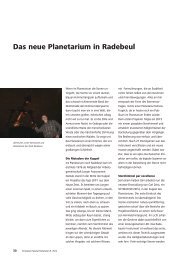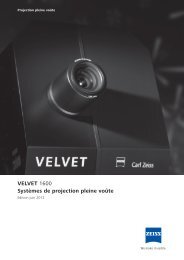Innovation Special Planetariums 9 - Carl Zeiss Planetariums
Innovation Special Planetariums 9 - Carl Zeiss Planetariums
Innovation Special Planetariums 9 - Carl Zeiss Planetariums
You also want an ePaper? Increase the reach of your titles
YUMPU automatically turns print PDFs into web optimized ePapers that Google loves.
Quo vadis, Planetarium?<br />
Wilfried Lang<br />
<strong>Carl</strong> <strong>Zeiss</strong>, Planetarium Division<br />
I already wondered about this a few years ago and shared my<br />
ideas with all of you at the time. Today, I take the liberty to repeat<br />
this question now, after almost 20 years of working in the<br />
planetarium and telescope development area at <strong>Carl</strong> <strong>Zeiss</strong> and<br />
more than 20 years of responsibility for the planetarium business<br />
at <strong>Zeiss</strong>, and after gaining a great deal of experience with<br />
digital fulldome systems. I would like to emphasize that these<br />
are my personal thoughts, and that each of you is free to reflect<br />
on the extent to which they may apply to your own planetarium,<br />
or not, or whether you can identify with them at all.<br />
Fulldome systems and their attributes<br />
A couple of years ago I was not yet able to realize to what<br />
extent fulldome systems would revolutionize planetariums, but<br />
today I can come to a clear conclusion: for many planetariums,<br />
fulldome systems are more of a curse than a blessing. This<br />
conclusion of mine will certainly come as a great surprise to<br />
most of you, because particularly we here at <strong>Carl</strong> <strong>Zeiss</strong> have<br />
offered a great many innovations in this area to planetarium<br />
users. However, hidden behind attributes such as modernity,<br />
currency, multimedia, flexibility, and interaction, which are<br />
generally considered to be associated with fulldome systems,<br />
are many facilities of which one could easily say the exact contrary.<br />
There, the standard has distinctly dropped. This concerns<br />
both the projection quality and also the quality of the planetarium<br />
shows themselves, because the purchase of a fulldome<br />
system quite often also results in scientific personnel being<br />
dispensed with. After all, today a push of a button suffices<br />
to “play planetarium”. Frequently this follows the sales pitch<br />
of our competitors, who would like to make believe that an<br />
opto-mechanical projector is today superfluous, and that it can<br />
be replaced with digital projectors with ever higher resolutions<br />
and ever greater brightness. Of course, the experts among you<br />
know that this is certainly not the case. A night sky in which a<br />
star that is only just barely visible in nature is represented with<br />
a pixel and brighter stars with n times a pixel is after all just a<br />
22 <strong>Innovation</strong> <strong>Special</strong> <strong>Planetariums</strong> 9, 2012<br />
generic sky, which bears no relation to what can really be seen<br />
in nature, quite apart from the gray color of the background<br />
of all standard video projectors that all our competitors have<br />
to make do with. 3D animations and computer clusters with<br />
up to 50 individual computers are now supposed to suggest<br />
greater modernity. The only thing is that, in addition to a technology<br />
that is far too complex, these new systems also involve<br />
production costs that climb to literally astronomical heights.<br />
Live events and interaction with visitors, as we understand it<br />
at <strong>Carl</strong> <strong>Zeiss</strong> and as can be expected by visitors in a good planetarium,<br />
are barely possible with such technologies.<br />
A downward trend in spite of a shift in technology?<br />
Until now I have not said anything about the quality of the<br />
planetarium events or performances on offer. Here, too, some<br />
people think that the new fulldome technology makes everything<br />
incredibly and wonderfully modern, especially if the<br />
shift in technology also involves a change of generation in the<br />
planetarium personnel. After all, the idea behind it all is to get<br />
rid of the old mustiness associated with planetariums once and<br />
for all.<br />
Just take a look at the result in the many planetariums of<br />
the world: the former planetarium has been remodeled into<br />
a dome cinema, in which commercially shows are, at best,<br />
voiced over into the relevant country’s language. Yes, a big<br />
hello from IMAX! And yet the comparison with the IMAX is<br />
not entirely fair, as it did, and still does, potentially offer quality<br />
in terms of both content and the projection technology.<br />
And yet it has not been possible to stop the downward trend.<br />
This downward trend, in reality a slow death, will take place<br />
much faster in the planetariums that are operated in this way,<br />
because the content of the shows is often more than poor as<br />
a result of inadequate production budgets. In the planetariums<br />
managed in this way, the interaction or communication with
















